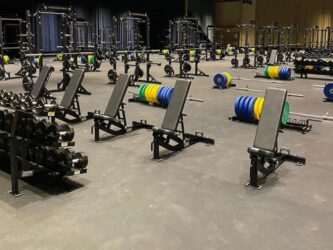
You may have heard about the rash of knee injuries in professional women’s soccer lately. Or maybe not since, after all, women’s sports in general get such poor coverage. Don’t even get me started on that.
Okay, so if you’re an uber-fan of women’s soccer like I am then you would be very aware of the number of top players who will not be participating in this summer’s World Cup due to knee ligament injuries, specifically the anterior cruciate ligament or ACL. The ACL is the major stability ligament of the knee. If you tear it you pretty much have a Bambi leg.
Go ahead. Just Google women’s soccer ACL injuries and you’ll be shocked. The list now includes Canada’s own Janine Beckie, the Netherlands’ Vivianne Miedema, Brazil’s Ludmila, Spain’s Alexia Putellas, France’s Marie-Antoinette Katoto, and Denmark’s Nadia Nadim as well as many others – thirty-six to be exact. Thirty-six of the world’s top players are out with the same injury.
To be clear, if there was an injury epidemic like this taking out the top players in the men’s game you had better believe someone would be sounding the alarm. But the women are just expected to truck on. There has been lots of talk lately about why this is happening. Of course a lot of it is blaming hormonal cycles and other such things exclusive to people with uteruses. I, for one, don’t believe this is the sole reason.
It is well documented that women’s soccer receives a very small fraction of the resources that the men’s game does. From quality of training pitches and facilities, to coaching, to demanding schedules, the women get the short end of the stick every time.
As they say, a picture is worth a thousand words so let’s just let these photos speak for themselves.


These are the weight rooms provided for the NCAA basketball March Madness tournament in 2021. Due to the pandemic the players were kept in a strict bubble for three weeks so they couldn’t go elsewhere to train. It’s not hard to guess which one was for the women. These things are happening at a multi-million dollar tournament in 2021, so I’m guessing there are limitations in the soccer world as well where the women are grossly underfunded and underpaid.
Several players have also voiced concerns about the schedules they are expected to keep but no one is listening. The number of games some of the women are now playing has increased exponentially over a very short period of time with no gradual ramp-up. The women don’t necessarily play more than the men, but they do it without the proper support.
The solution to the problem is obviously going to be complex and multi-faceted. However, I believe that trying to address the problem at the professional level is missing a crucial period when the problem actually starts, and that is pre-puberty and puberty.
My daughter currently falls into this age group and she is playing with a competitive club. Her current club seems to be providing equal quality training to the boys and the girls, but her previous club definitely treated the girls as second-class citizens. This puts them at higher risk of injury in my opinion. My daughter practices with the kids her age and one year older. Looking at the players on the field it is obvious that they are in various stages of peripubertal development.
The crucial element that happens to girls that doesn’t happen to boys in puberty is a significant change in the shape of the pelvis. This widens the angle of the hips and changes the relationship of the muscles around the knee since the large muscle groups that protect the knee are attached at both ends. For more detail on this, see my blog post on sports injuries in young girls.
I believe that if the resulting muscle imbalances are not dealt with in the peripubertal period, then the player goes on growing and strengthening wile trying to compensate for these issues. Most of us weekend warrior athletes can get away with this. Professional footballers cannot, nor can highly competitive youth players. Eventually they will pay, and that is exactly what we are seeing now.
Girls are far more likely than boys to injure the ACL playing sports, and soccer has one of the highest incidences of this injury due to the quick pivoting nature of the game. Studies show an absolute minimum of four to six times more likelihood of ACL injury in girls with some studies suggesting up to 20 times more in women versus men.
So if your daughter is an athlete, particularly a soccer player what can you do? I believe that seeing a physiotherapist who can assess for alignment and muscle imbalance issues is essential. This is particularly important to do as the pelvis starts to change shape and widen. It is also important to go back for tune-ups over time as the changes to the pelvis happen over an extended period.
The other issue to consider is growth. Girl’s bodies are not only changing shape in this period, they are growing. As bones grow, muscles have difficulty keeping up and so they can become quite tight. Click here for more details on how this works. This too can contribute to imbalances and increase the risk of injury. A physiotherapist familiar with the effects of growth on the body can help with this as well.
Another significant factor to be addressed is an emphasis on stability in training. All too often kids are practicing agility drills when they don’t have the stability to do so without risking injury. Agility without stability is a car without brakes. It’s an accident waiting to happen.
Simple things like yoga and squats with proper form can do wonders for improving stability. The word football governing body (FIFA) has developed a programme called FIFA 11+, which is a specific series of warm-up exercises with emphasis on stability and proper form. This programme is available for free and has been shown to reduce injury rates. These things should be standard in training programmes, especially for peripubertal girls.
I believe that we can reduce the incidence of ACL injuries in girls and women by intervening early. And by the way, it’s never too late to address these issues. We can help regardless of age or playing level. Let’s not all become statistics.